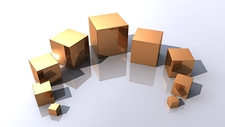Non-Standard Measurement Units

TEKS Objective
The student is expected to measure and compare organisms and objects using non-standard units that approximate metric units.
Essential Understanding
The student uses age-appropriate tools and models to investigate the natural world.
Science Background
Classroom Case Studies Grade K-2: Annenberg Learner (website) - Class case studies enable examination of how children in grades K-2 think about and work with measurement concepts, including those of area and relative size. Also includes strategies for presenting related content in your own classes.
Classroom Case Studies Grade K-2
Annenberg Learner, www.learner.org
The Metric System, Metric and Scientific Notation: Visionlearning (website) - Information about the history, unit measures and notation of the metric system.
The Metric System, Metric and Scientific Notation
Visionlearning, www.visionlearning.com
Signature Lesson
The Length of My Feet: Illuminations Resources for Teaching Math (website) - Students learn about and employ nonstandard units to measure and compare the length, size and/or distance of different items; and they understand that length is a measurable attribute of objects.
The Length of My Feet
Illuminations Resources for Teaching Math, illuminations.nctm.org
- Supporting Lessons
- Extensions
- Assessment Ideas
- Literature Connections
- Related
TEKS - Additional Resources
Supporting Lessons
Estimation and Measurement: Science NetLinks (website) - Learn to estimate and measure using unconventional (non-standard) units.
Estimation and Measurement
Science NetLinks www.sciencenetlinks.com
Assessment Ideas
Have students use non-standard units, such as centimeter cubes, to measure and record the length, width and capacity of a plastic container.
Literature Connections
Measuring Penny. Leedy, Loreen (ISBN-13: 978-0805065725)
Measurement. Dowdy, Penny (ISBN-13: 978-0778743590)
Additional Resources
Learning Time: Measurement with Sid the Science Kid: PBS Video (Video) - Students watch simple measurement investigations
TEKS Navigation
Grade 2
Need Assistance?
If you need help or have a question please use the links below to help resolve your problem.

Comments